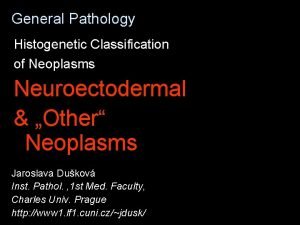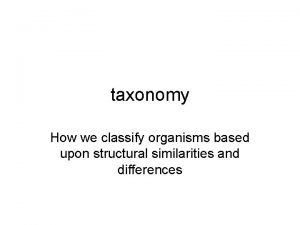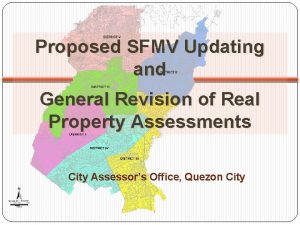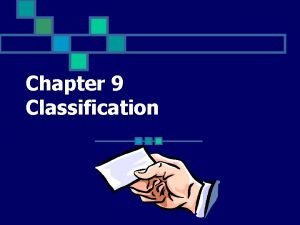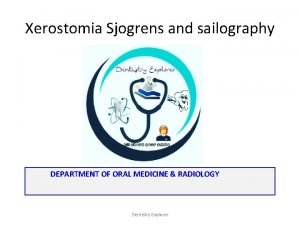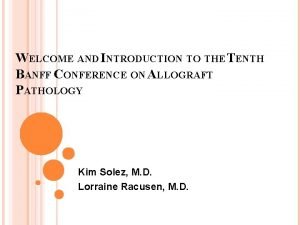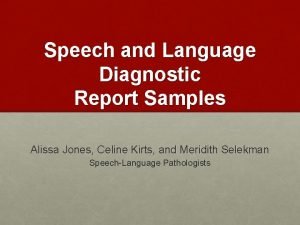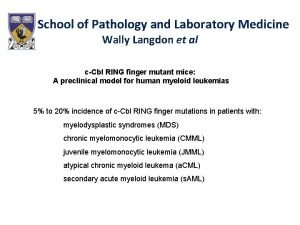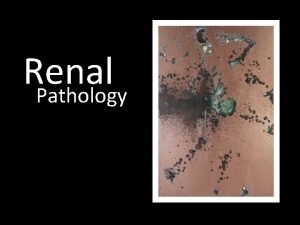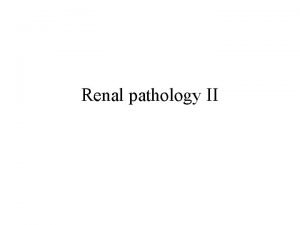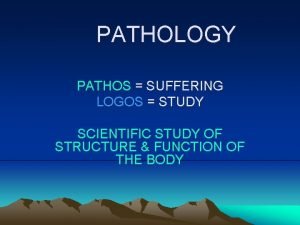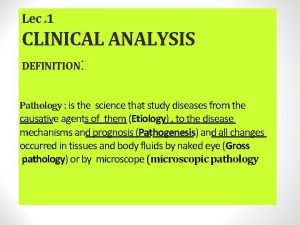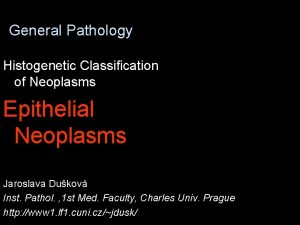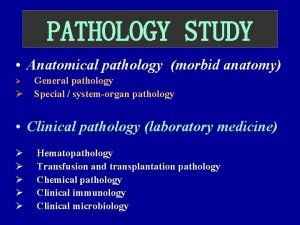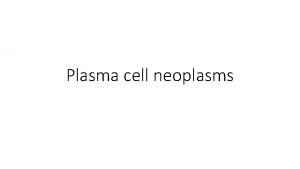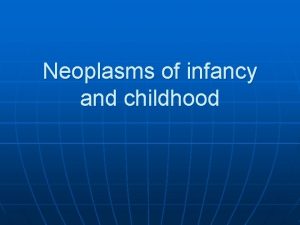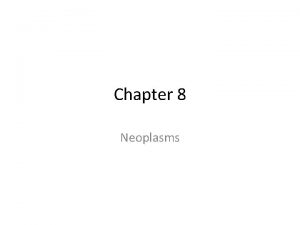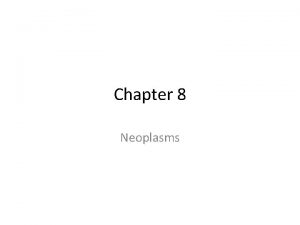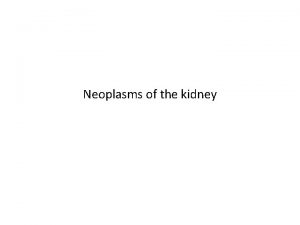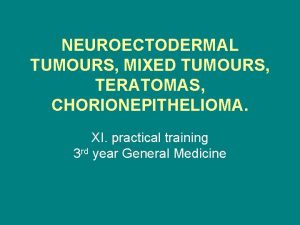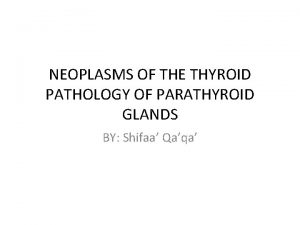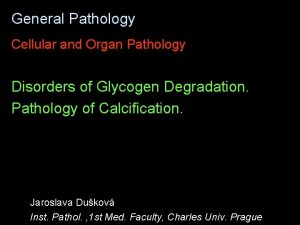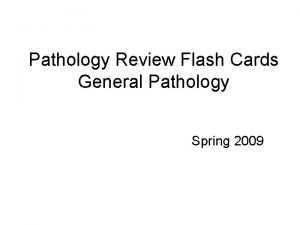General Pathology Histogenetic Classification of Neoplasms Neuroectodermal Other




























- Slides: 28

General Pathology Histogenetic Classification of Neoplasms Neuroectodermal & „Other“ Neoplasms Jaroslava Dušková Inst. Pathol. , 1 st Med. Faculty, Charles Univ. Prague http: //www 1. lf 1. cuni. cz/~jdusk/

NEOPLASIA – classification HISTOGENETIC v v v mesenchymal epithelial neuroectodermal mixed, teratoma choriocarcinoma mesothelioma

Neuroectodermal Tumours derived from: CNS & PNS located v ganglion cells v glial & Schwann cells v mixed (ganglion and glial cells) v gangliocytoma, neuroblastoma gliomas, neurilemmoma glioblastoma, neurog. sarcoma, ganglioma, ganglioneuroma melanocytes pigmented nevi melanoma

WHO Clasification of Tumours of the Nervous System (WHO 2000) - 1. v Glial cell tumours v astrocytic v oligodendroglial v mixed (oligo-astro) v ependymal v choroid plexus v glial tumours of uncertain origin v v Neuronal and mixed neuronal-glial tumours Neuroblastic Pineal parenchymal tumours Embryonal tumours

WHO Clasification of Tumours of the Nervous System (WHO 2000) - 2. v Tumours of peripheral nerves v v v Schwannoma (neurilemmoma) Neurofibroma Perineurioma Malignant peripheral nerve sheet tumour (MPNST) Tumours of the meninges v v v Tumours of meningotelial cells – meningiomas Mesenchymal non-meningothelial tumours Primary melanocytic lesions

WHO Clasification of Tumours of the Nervous System (WHO 2000) - 3. v Lymphomas and haemopoietic neoplasms v malignant v v v Germ cell tumours v v v germinoma embryonal sarcoma yolc sac tumour choriocarcinoma teratoma (mature, immature) Tumours of the sellar region v v v lymphomas plasmocytoma granulocytic sarcoma craniopharyngioma granular cell tumour Metastatic tumours

Gangliocytoma Def. : well differentiated slowly growing neuroepithelial tumour composed of neoplastic mature ganglion cells Age /sex – no special predisposition (diagnosed mostly in childhood – young adults) Incidence: RARE Histogenesis: most probably highly differentiated remnants of embryonal neuroblasts

Neuroblastoma (WHO: Neuroblastic tumours of adrenal gland sympathetic nervous system) Def. : childhood embryonal tumours of migrating neuroectodermal cells derived from the neural crest and destined for the adrenal medulla and sympathetic nervous system Age /sex – 96% in the 1 st decade , no sex predilection Incidence: most common solid extracranial malignant tumours during the first two years of life Histogenesis: see definition Clinic: palpable mass (retroperit, abd. , cervical), X-ray thoracic Macro: soft gray-tan mass, regressive changes Micro: undiff. + differentiating neuroblasts Variants: neuroblastoma (undiff. ), ganglioneuroblastoma intermixed, ganglioneuroblastoma nodular, ganglioneuroma Behaviour: malignant, dependent on age and histology variant

Neuroectodermal Tumours derived from: CNS & PNS located v ganglion cells v glial & Schwann cells v mixed (ganglion and glial cells) v gangliocytoma, neuroblastoma gliomas, neurilemmoma glioblastoma, neurog. sarcoma, ganglioma, ganglioneuroma melanocytes pigmented nevi melanoma

Paraganglioma Def. : benign neuroendocrine neoplasm arising in specialised neural crest cells associated with autonomic ganglia Macro: encapsulated , solid Micro: uniform cells forming compact nests (Zellballen) Biology: benign

Phaeochromocytoma Def. : benign tumour of of chromaffin cells (intraadrenal paraganglioma) Macro: whittish, solid, regressive changes Micro: solid alveolar (Zellballen) Behaviour: benign (15% bilateral, 10% in children, 10% malignant) MEN II and von Hippel-Lindau disease component

WHO Clasification of Tumours of the Nervous System (WHO 2000) - 2. v Tumours of peripheral nerves v v v Schwannoma (neurilemmoma) Neurofibroma Perineurioma Malignant peripheral nerve sheet tumour (MPNST) Tumours of the meninges v v v Tumours of meningotelial cells – meningiomas Mesenchymal non-meningothelial tumours Primary melanocytic lesions

Neurilemmoma (WHO Schwannoma) Def. : a usually encapsulated benign tumour composed of differentiated neoplastic Schwann cells Age /sex – all ages, peak 4 -6 th decade , no sex predilection Incidence: common solid head, neck, extremities, INTRACRANIAL intramedullary Histogenesis: see definition Clinic: periph. - palpable asymptomatic mass, intraspinal – pain, intracranial – cerebellopontine lesion symptoms – eharing, tinnitus, facial paresthesias Macro: white, soft – firm, encapsulated, (+nerve) Micro: elongated Schwann cells , palisading, Verocay bodies Variants: Antoni A, B, biphasic, cellular, pigmented, plexiform Behaviour: slowly growing, benign, malignant transformation rare

WHO Clasification of Tumours of the Nervous System (WHO 2000) - 2. v Tumours of peripheral nerves v v v Schwannoma (neurilemmoma) Neurofibroma Perineurioma Malignant peripheral nerve sheet tumour (MPNST) Tumours of the meninges v v v Tumours of meningotelial cells – meningiomas Mesenchymal non-meningothelial tumours Primary melanocytic lesions

Neurofibroma Def. : a well demarcated intraneural or diffusely infiltrative extraneural tumour consisting of a mixture of cell types including Schwann cells, perineuriallike cells, and fibroblasts. Multiple in Nerofibromatosis 1. Age /sex – all ages, no sex predilection Incidence: common Clinic: palpable asymptomatic mass, mostly cutaneous nodule (s) ass. with café-au-lait spots Macro: white, firm, circumscribed Micro: elongated Schwann cells , fibroblasts, Wagner-Meissner-like tactile corpuscles Variants: atypical, cellular, plexiform, may be pigmented Behaviour: slowly growing, benign, malignant transformation rare – mostly in plexiform variants

Neuroectodermal Tumours derived from: CNS & PNS located v ganglion cells v glial & Schwann cells v mixed (ganglion and glial cells) v gangliocytoma, neuroblastoma gliomas, neurilemmoma glioblastoma, neurog. sarcoma, ganglioma, ganglioneuroma melanocytes pigmented nevi melanoma

Neuroectodermal Tumours derived from: CNS & PNS located v ganglion cells v glial & Schwann cells v mixed (ganglion and glial cells) v gangliocytoma, neuroblastoma gliomas, neurilemmoma glioblastoma, neurog. sarcoma, ganglioma, ganglioneuroma melanocytes pigmented nevi melanoma

WHO Clasification of Tumours of the Nervous System (WHO 2000) - 2. v Tumours of peripheral nerves v v v Schwannoma (neurilemmoma) Neurofibroma Perineurioma Malignant peripheral nerve sheet tumour (MPNST) Tumours of the meninges v v v Tumours of meningotelial cells – meningiomas Mesenchymal non-meningothelial tumours Primary melanocytic lesions

Melanocytic Skin Lesions - 1. v Freckle – ephelis – a hyperpigmented macule due to increased melanin amount in a normal density of melanocytes v Lentigo simplex - small well circumscribed hyperpigmentation due to increased frequency of basal melanocytes v Café-au-lait spots – hyperpigmented keratinocytes. In neurofibromatosis present at birth. v Naevus spilus (congenital) – up to 10 cm in diam. lentiginous and JUNCTIONAL foci v Dermal melanocytoses – blue spots Ota, melanocytic hamartomas) (mongolian, n. Ito, n.

Melanocytic Skin Lesions - 2. v Acquired melanocytic nevi – junctional – dermal – compound – deep dermal (blue) nevus v Congenital melanocytic nevus

Man 56 yrs v progressive N 416/02 neurological symptoms v brain CT negative v CSF – no signs of inflammation – scattered atypical cells – neoplasm? – systemic degeneration?

Diagnosis Morbus principalis: Melanoma malignum originis ignotae generalisatum. Complicationes: Metastases tumorosae multiplices cerebri, medullae spinalis, myocardii et renum. Haemorrhagia lobi frontalis hemisphaerii sin. cerebri. Endocardiosis marantica valvae mitralis. Infarctus recentes aliquot lienis, renum et cerebri.

Diagnosis Causa mortis: Generalisatio tumorosa. Oedema cerebri. Inventus accessorius: Anthracosis pulmonum et lnn. thoracalium. Urocystitis heamorrhagica acuta. Struma colloides nodosa gl. thyreoideae. Cholesterolosis vesicae felleae.

NEOPLASIA – classification HISTOGENETIC v v v mesenchymal epithelial neuroectodermal mixed, teratoma choriocarcinoma mesotelioma

Other Tumours v v mixed tumours trophoblast choriocarcinoma v teratoma coetaneous – differentiated embryonal – nondifferentiated v mesothelioma fibromesothelioma, adenomatoid tu. biphasic (mesot. ca)

Mixed Tumours Def. : Tumours (benign or malignant) composed of two or more different cell lines that are normally present in the place of tumour origin

Teratomas Def. : Tumours (benign or malignant) composed of two or more different cell lines that are NOT normally present in the place of tumour origin

Germ cell tumours – germinoma – embryonal sarcoma – yolc sac tumour – choriocarcinoma – teratoma (mature, immature)
 Morbus principalis
Morbus principalis Peripheral giant cell granuloma
Peripheral giant cell granuloma Primitive neuroectodermal tumor
Primitive neuroectodermal tumor Primitive neuroectodermal tumor
Primitive neuroectodermal tumor Self-initiated other-repair
Self-initiated other-repair Planos en cinematografia
Planos en cinematografia Where did general lee surrender to general grant?
Where did general lee surrender to general grant? Most general to most specific classification
Most general to most specific classification Report text structure and example
Report text structure and example General revision of assessments and property classification
General revision of assessments and property classification Most general to most specific classification
Most general to most specific classification Most general to most specific classification
Most general to most specific classification Most general to most specific classification
Most general to most specific classification Dances found in specific locality
Dances found in specific locality Cherry blossom appearance in sjogren's syndrome
Cherry blossom appearance in sjogren's syndrome Define seed pathology
Define seed pathology Banff pathology course
Banff pathology course Pathology job market
Pathology job market Pathology outline
Pathology outline Sample diagnostic report for speech-language pathology
Sample diagnostic report for speech-language pathology Rph pathology
Rph pathology Septae
Septae Benign nephrosclerosis pathology outlines
Benign nephrosclerosis pathology outlines Kidney pathology
Kidney pathology Pathos pathology
Pathos pathology Systemic pathology mcq with answers pdf
Systemic pathology mcq with answers pdf Leeds uk virtual slides
Leeds uk virtual slides Clinical pathology meaning
Clinical pathology meaning Pathology branches
Pathology branches
